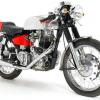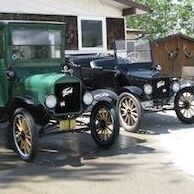Contributor Leaderboard
Popular Content
Showing content with the highest reputation on 19/09/19 in all areas
-
Hi Alan! It was the coal washery plant tower. All the pit's coal output went through this process,cos no coal was ever just perfectly clean coal! When the coal was brought to "BANK"..[..The surface!],it went first to the screens,which were flat conveyor belts,where, usually,older disabled men,and young boy trainees,stood at each side of the belt,and hand-picked what stones they could,and threw them down a chute which took the stones,plus any other rubbish like pieces of damaged conveyor belt,old steel stranded haulage rope ,etc,into a waiting railway truck underneath the screens,or onto another short conveyor belt which took the waste into the big hopper which you might have seen travelling up the pit heap to be emptied at the top of the heap. The coal was then taken by conveyor belt up and into that big round washery tower,which was full of water,being swirled around to create a vortex,like a big whirlpool,into which was added a product called "Magnatite",the purpose of this being to cause the coal to float like bits of wood,and allowing the heavier material and waste products to sink to the bottom. In a nutshell,it was a separation plant. Noo! ..that's the bit aa knaa,but how they retrieved the coal,and the washed out waste stones etc,without leaking water oot...is still a puzzle to me,and it's something aav nivvor thowt aboot,Alan,since the pits closed doon. A dae remember being curious aboot the process,and asking Russel,the Shaftman/Joiner,who took me and me Son up the heedgear,ti get them excellent shots from the pit wheels,but aav forgotten noo. A think we might find oot on Google,surely somebody has posted info of the process online!..not often HPW is stumped on mining,but I was never up there in the washery,only the plant Attendants,and maintenance men were allowed in there,due to the chemicals being used..probably. This process was used at most "Modern"-ish pits,with the exception of the old Choppington High Pit! Did you notice how,on your posting of the old O.S. maps of Choppington,that the "A" pit,[or "LowPit"],was drawn out with all the buildings around it,whilst the High Pit is shown as just a "dot" saying the word..."Colliery"..of little importance...! All pits in the sight of the public main roads,were fancy girder-framed and brick-built buildings...a sign of modern industry and investment..methinks! On the contrary,the High Pit,was sunk over the fields,out of sight to most passers-by,and was all corrugated sheet-clad,like the old shanty towns you see in the old west in the States of the early days...[ a virtual hillbilly shack type of vibe!]. Now when I started in 1959,the weather had taken it's toll on the wrinkly tin sheets,and they banged and rattled,with loose sheets flapping in the wind...and freezing in the winter,inside! Noo,the washery there,WOULD have been modern,in it's day,and consisted of a massive flat platform,aboot 30 feet long,by aboot 8 feet wide,and which was mounted on a rolling carriage,which in turn,ran on rails. The platform was called a "Shaker",cos it moved back and forth ,driven by a huge connecting rod and crankshaft,which was driven by a webbing belt running on a motor,like the farmers use to drive implements from the tractor auxiliary pulley. The crankshaft throw was only aboot 3-4 feet,at the most,but when it was running,the sheer end-of-stroke,shock,as it changed the direction of the huge platform,was enough to make the whole Heapstead building move in sympathy,so if you were getting your bait,you had to hold your cup of tea in an outstretched hand, at arms-length,or you would be spilling tea over yourself...worse than the old steam tankeys![ the shaker frequency was aboot once per second..and was a violent thump..each time] Noo wat a missed oot was,this platform had rows of various sized holes along its length,the smallest ones being nearest to where the coal was tipped onto from the tipplers above which turned the pit tubs upside doon,and tippped the load down a chute and onto the "Washer"..[which this platform was.] At different places along the washer,the rows of holes got bigger,and bigger,and high pressure water sprays were mounted aboot two feet above the platform,on a separate frame. If you can visualise this,Alan,here you had this huge machine shaking violently,back and forth,aboot three feet each way,and the machine was built with a slight gradient up-over,with a series of steel thin strips welded on the flat platform,running crossways,and aboot a foot apart,aal the way alang it's length,so as the coal was tipped on,it was shaken up the gradient on the bed,washed clean by the sprays,[pure water-no chemicals at all!],the coal "crept" up the washer,with the smaller "Nuts" falling through the smaller holes,into the railway trucks underneath,the "Singles"..[house-hold sized coal],fell through the next rows of larger holes,the "Doubles",.."Trebles",..and "Cobbles",all fell through respective holes,which was an effective way of grading the coal out..and a lot cheaper than the later washery,and environmentally friendly also!! Finally,any larger stones which escaped the grading holes,were shaken over the edge,tipped straight onto a steel flat sheet,hand-loaded into a wheelbarrow,and wheeled around the floor past the screening belts,and tipped down a chute into the "stone " truck below. That was a hard,thankless task for an old miner,and which had been done since the washer was installed in the early 1900's![it was like that in 1929,when my Father started up on the screens as a 14 year old miner..] It all changed as soon as HPW had short spells on the screens as a 15 year old trainee! I watched this little old man every day I was up there,[cos my main job was in the timber yard],and one day,I plucked up the courage to tell the "Keeker",[Chargeman]..Jimmy Framm,a suggestion,which aa thowt he wud tell me ti....yi knaa wat! Whey Jimmy knew,and remembered my Father well,and had taken a liking to me,cos a was a quiet hard worker,so he listened to what a had ti say. Next thing aa knew was ,within a few days,the Blacksmiths were burning a hole in the floor where the all the stones tipped from the washer,constructing a steel chute,with the purpose of directing the tipped stones directly into the stone truck below,saving a man's wasted labour!! Only one of my claims to being an unrecognised inventor at the pits,in my pit life! Somebody else would always get the credit for my inventions,usually a Deputy,or or Overman,cos they were the ones that took my suggestions to the Management,to get things done and put in place...same in the furniture trade...I was robbed of credit there as well! Not that I was going ti be paid anything,just nice to be recognised and appreciation shown! Well Alan,I hope you are a bit wiser now,and you might have found my recollections interesting..if not tiring to read! Cheers Alan! Bill.2 points
-
Whey,me comment posted by itsell afore a was finished,and when a tried ti edit by adding more text,it wadn't save,so me detailed description of the screens and heapstead was wiped..! The last sentence above should read as: " ....before the Government inspectors and Area Director and Safety in Mines People aal came ti the pit" The next night's Evening Chronicle read ..." a safety guard rail has since been erected aound the machinery..." Just came to me,they have the same steel-plated four foot wide flat conveyor belts on the screens at Beamish museum,the only other place where I have seen these deadly peices of machinery,deadly, cos the plates used to get bent up with hard bits of stone becoming trapped in the guides,and sharp, long bits of swarf edge spikes used to rip your hands and arms,as they were concealed under the load of wet coal and stone slurry on the belt. Malcom Mckenna,the washery tower looks like a giant ice cream cornet..whey, a bit like one..! Thanks again Vic for helping me oot! Cheers Alan! Bill.1 point
-
Well,that was a fine example of pooled education!...We are aal wiser and richer noo!.....thanks Vic for rescueing me here,a remember noo,aboot the drum,thanks to your prompting my grey matter,but aal the rest of the fascinating information aboot thi other processes are completely new to me. A nivvor saw another improvised Washery like the one aa described that was at the High pit..when a say "Improvised" ..it's not be taken lightly!..A lot of engineering,went into thi making of that mechanical monster! The single-throw crankshaft was forged from steel maybe a foot thick,maybe more or a wee bit less,as was the connecting rod. The bearing saddles had to be massive also,to withstand the forward/reverse motion,and inertia which was sufficient to move the whole of the screens and upper heapstead,where all the tipplers and creepers were..and which were all built on heavy girder stilts. The platform weighed a canny few tons,and danced back and forward as if it were a kids toy. Noo! We stood wi wor backs to this moving and rackety deafening monster,with a gangway separating the sreening belts,only aboot four feet wide,so if yi fell backwards,which ye med sure yi didn't,ye wud hae ya arms tekking off by the carriage wheels which ran on rolleyway rails,and which went completely unguarded from installation,until Old Jimmy,the oiler and greaser,got trapped in the moving machinery,sustaining fatal injuries...then within hours of Jimmy's death,the Blacksmiths,engineers,and senior management,were all up there installing guard handrails aal aroond the washer,before1 point
-
Bill, a very good explanation of the coal preparation, if it was similar to the plants i'm familiar with there was another two important processes, one to recover the expensive magnetite and one to recover the fine coal washed off the screens. The magnetite was recovered using a large drum that was an electromagnet on one side, as it turned the magnetite clung to the upward turning of the drum but dropped off the downward side which wasn't magnetic, and recycled. The fine coal washed off the screens was mixed with more water and an added flocculant, a chemical that created lots of bubbles when injected with compressed air, the bubbles were skimmed off and then flowed through a tank that had large wheels made up of metal mesh screen panels, large vacuum pumps sucked the fines onto the screens and then scraped off and diverted onto a conveyor then dropped into a centrifuge that spun out most of the water. All water used went to settling ponds. Not a lot of waste.1 point


